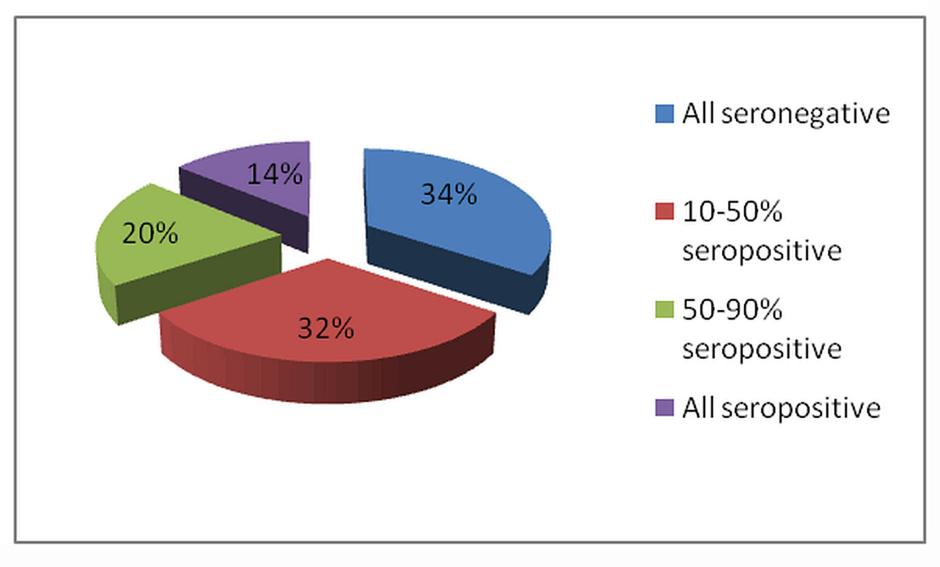Research on BVD at AFBI
Veterinary Sciences Division of the Agri-Food and Biosciences Institute has a record of producing quality research on BVD virus.
The research carried out in AFBI on BVD
Previous studies looking at the level of antibodies for bovine viral diarrhoea virus (BVDV) in bulk milk samples from 929 Northern Ireland (NI) dairy herds found that close to 50% of the herds tested had a high level of antibodies and the annual incidence risk of new infections was in the range of 0.133 to 0.477 (Graham et al, 2001).
Graham, D.A., German, A., McLaren, I.E., Fitzpatrick, D.A. (2001) Testing of bulk tank milk from Northern Ireland dairy herds for viral RNA and antibody to BVDV. Veterinary Record 149, 261-265
Bulk milk study
A recent study has revealed more widespread exposure to BVDV in NI dairy herds. Bulk tank milk samples from 181 dairy herds were tested for antibodies to BVDV and for BVD virus by real time reverse transcription polymerase chain reaction (RT-PCR). On the antibody test, none of the farms gave a negative result. Results from 9 herds (5%) suggested that they had been free of infection for several years. However, results in the majority (95%) of herds suggested that a moderate to high number of lactating animals within these herds had been exposed to BVD virus.
In a proportion of these herds it is anticipated that infection is still active, with typically one or more PI cattle being present. BVD virus was detected in 18 bulk milks (10%) when tested by RT-PCR. This result confirmed the presence of one or more BVD virus positive cows among those contributing to the milk in the day that the sample was taken. 16 out of the 18 positive herds were vaccinating for BVD and some of them had been vaccinating for BVD for as long as 10 years indicating that vaccination on its own is not an effective control method.
Prevalence study
Agrisearch, in conjunction with the DAERA Research Challenge Fund, have funded a recent study to estimate the prevalence of suckler and dairy herds in Northern Ireland (NI) with serological evidence of current or recent circulation of BVDV. Dairy and suckler herds undergoing a routine brucellosis herd screen between April 2011 and June 2012 were randomly selected. The herds were marked on APHIS to indicate that the herd keepers were to be invited to participate in the survey.
If they agreed, they were contacted by AFBI laboratory staff in order to complete a questionnaire on herd management and vaccinations. Only dairy herds with a minimum of 20 milking animals (cows over 24 months in milk or calf) and suckler herds with a minimum of 10 breeding animals (female breeding cattle over 24 months) were eligible to be included in the study. The blood samples were sent to the Agri-Food and Biosciences Institute (AFBI) Veterinary Sciences Division, Stormont.
Herds were tested using a young stock check test as per the AFBI Cattle Health Scheme. A minimum of 5 and a maximum of 10 homebred young animals (12-24 months of age) per herd were tested for evidence of antibodies to BVDV. An absence of antibodies in this group indicated that they have not been in contact with BVDV, typically from an animal persistently infected with the virus, and is strong evidence of absence of current infection in that herd. On the other hand, the presence of antibodies in one or more animals indicates that virus has been circulating in the herd within the last two years, and therefore the herd is currently (or has recently been) infected with BVDV. A total of 589 herds and 5,161 individual samples were tested.
In 34% (202) herds all animals tested were seronegative; in 14% (83) herds all animals were seropositive. In the remaining herds, one or more animals were positive for BVDV antibodies (Fig 1). In summary, 66% of the herds had at least one seropositive animal, indicating that they had been in contact with the virus.
The levels of exposure of herds to BVDV in Northern Ireland found in this study indicate that after initial testing, a high percentage of the herds would require follow up testing to achieve eradication.
